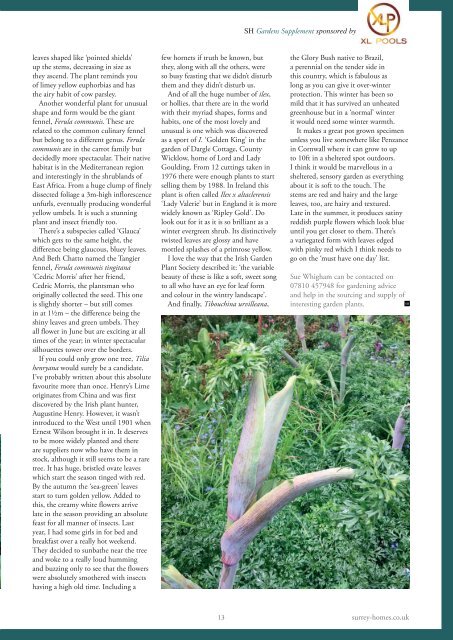Surrey Homes | SH66 | April 2020 | Gardens supplement
The lifestyle magazine for Surrey - Inspirational Interiors, Fabulous Fashion, Delicious Dishes
The lifestyle magazine for Surrey - Inspirational Interiors, Fabulous Fashion, Delicious Dishes
You also want an ePaper? Increase the reach of your titles
YUMPU automatically turns print PDFs into web optimized ePapers that Google loves.
SH <strong>Gardens</strong> Supplement sponsored by<br />
leaves shaped like ‘pointed shields’<br />
up the stems, decreasing in size as<br />
they ascend. The plant reminds you<br />
of limey yellow euphorbias and has<br />
the airy habit of cow parsley.<br />
Another wonderful plant for unusual<br />
shape and form would be the giant<br />
fennel, Ferula communis. These are<br />
related to the common culinary fennel<br />
but belong to a different genus. Ferula<br />
communis are in the carrot family but<br />
decidedly more spectacular. Their native<br />
habitat is in the Mediterranean region<br />
and interestingly in the shrublands of<br />
East Africa. From a huge clump of finely<br />
dissected foliage a 3m-high inflorescence<br />
unfurls, eventually producing wonderful<br />
yellow umbels. It is such a stunning<br />
plant and insect friendly too.<br />
There’s a subspecies called ‘Glauca’<br />
which gets to the same height, the<br />
difference being glaucous, bluey leaves.<br />
And Beth Chatto named the Tangier<br />
fennel, Ferula communis tingitana<br />
‘Cedric Morris’ after her friend,<br />
Cedric Morris, the plantsman who<br />
originally collected the seed. This one<br />
is slightly shorter – but still comes<br />
in at 1½m – the difference being the<br />
shiny leaves and green umbels. They<br />
all flower in June but are exciting at all<br />
times of the year; in winter spectacular<br />
silhouettes tower over the borders.<br />
If you could only grow one tree, Tilia<br />
henryana would surely be a candidate.<br />
I’ve probably written about this absolute<br />
favourite more than once. Henry’s Lime<br />
originates from China and was first<br />
discovered by the Irish plant hunter,<br />
Augustine Henry. However, it wasn’t<br />
introduced to the West until 1901 when<br />
Ernest Wilson brought it in. It deserves<br />
to be more widely planted and there<br />
are suppliers now who have them in<br />
stock, although it still seems to be a rare<br />
tree. It has huge, bristled ovate leaves<br />
which start the season tinged with red.<br />
By the autumn the ‘sea-green’ leaves<br />
start to turn golden yellow. Added to<br />
this, the creamy white flowers arrive<br />
late in the season providing an absolute<br />
feast for all manner of insects. Last<br />
year, I had some girls in for bed and<br />
breakfast over a really hot weekend.<br />
They decided to sunbathe near the tree<br />
and woke to a really loud humming<br />
and buzzing only to see that the flowers<br />
were absolutely smothered with insects<br />
having a high old time. Including a<br />
few hornets if truth be known, but<br />
they, along with all the others, were<br />
so busy feasting that we didn’t disturb<br />
them and they didn’t disturb us.<br />
And of all the huge number of ilex,<br />
or hollies, that there are in the world<br />
with their myriad shapes, forms and<br />
habits, one of the most lovely and<br />
unusual is one which was discovered<br />
as a sport of I. ‘Golden King’ in the<br />
garden of Dargle Cottage, County<br />
Wicklow, home of Lord and Lady<br />
Goulding. From 12 cuttings taken in<br />
1976 there were enough plants to start<br />
selling them by 1988. In Ireland this<br />
plant is often called Ilex x altaclerensis<br />
‘Lady Valerie’ but in England it is more<br />
widely known as ‘Ripley Gold’. Do<br />
look out for it as it is so brilliant as a<br />
winter evergreen shrub. Its distinctively<br />
twisted leaves are glossy and have<br />
mottled splashes of a primrose yellow.<br />
I love the way that the Irish Garden<br />
Plant Society described it: ‘the variable<br />
beauty of these is like a soft, sweet song<br />
to all who have an eye for leaf form<br />
and colour in the wintry landscape’.<br />
And finally, Tibouchina urvilleana,<br />
the Glory Bush native to Brazil,<br />
a perennial on the tender side in<br />
this country, which is fabulous as<br />
long as you can give it over-winter<br />
protection. This winter has been so<br />
mild that it has survived an unheated<br />
greenhouse but in a ‘normal’ winter<br />
it would need some winter warmth.<br />
It makes a great pot grown specimen<br />
unless you live somewhere like Penzance<br />
in Cornwall where it can grow to up<br />
to 10ft in a sheltered spot outdoors.<br />
I think it would be marvellous in a<br />
sheltered, sensory garden as everything<br />
about it is soft to the touch. The<br />
stems are red and hairy and the large<br />
leaves, too, are hairy and textured.<br />
Late in the summer, it produces satiny<br />
reddish purple flowers which look blue<br />
until you get closer to them. There’s<br />
a variegated form with leaves edged<br />
with pinky red which I think needs to<br />
go on the ‘must have one day’ list.<br />
Sue Whigham can be contacted on<br />
07810 457948 for gardening advice<br />
and help in the sourcing and supply of<br />
interesting garden plants.<br />
13 surrey-homes.co.uk


















